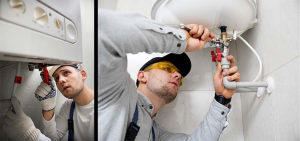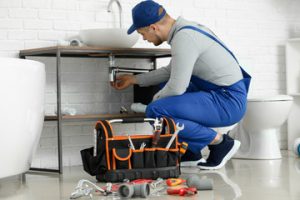A working, reliable water heater is an important home appliance that can keep your household running smoothly. Suppose you are experiencing any warning signs of a failing water heater. In that case, contacting professionals specializing in Water Heater Repair Aurora CO is best to ensure the issue is dealt with correctly.
If your water heater delivers tepid or low-volume hot water, the thermostat may be set too high, or one of the heating elements may fail. A professional can identify the problem and replace the element or thermostat to restore hot water production.

A rumbling, popping, or banging sound from your water heater could be caused by sediment buildup in the tank. Shut off the power to your water heater and drain it according to the manufacturer’s instructions. If these steps don’t work, you must replace your water heater.
Leaking Water
If you notice a puddle of water around your water heater, it could mean that the unit has a leak or is nearing the end of its lifespan and should be replaced.
Carbon Monoxide Exposure
If your gas water heater is not properly installed and vented, it can release carbon monoxide, an odorless gas that can cause stomach pains, dizziness, headaches, weakness, and mental fogginess. It is critical to hire professionals specializing in Water Heater Repair to properly install and maintain your gas or electric water heater.
Installation
Plumbing is a critical part of any home, but it’s not something homeowners can just dive into headfirst. Proper installation requires planning, quality materials, and adherence to local codes. Attempting to install plumbing without the proper knowledge can lead to leaks, water damage, and even health hazards like sewage backups. To avoid these issues, it’s best to work with a professional plumber during new construction or major remodeling projects.
The first step in plumbing installation is determining the location for pipes and other components. This involves making a layout plan, measuring the space, and deciding on the type and size of pipes needed. This step is particularly important for underground plumbing, as plumbers must take into account factors like soil conditions and potential flood risks.
After making a plan, the plumber must clear out the path for the pipes by removing existing walls, cutting away drywall, and lifting tile. Once the path is cleared, the plumber must then lay down the piping, connecting it to existing pipes where necessary. Plumbers use a variety of pipe materials, including copper, PEX, and ABS. Each has its own benefits, but copper is highly durable and corrosion-resistant. It also doesn’t contain any lead, which is a concern for many homeowners. PEX pipes are flexible, easy to weave through walls and ceilings, and can withstand high pressures. They’re also color-coded for hot and cold water, which makes them easier to identify when working on a project. Finally, ABS pipes are similar to PVC but are more resilient against freezing temperatures.
Once the piping is in place, the plumber can test for leaks and make any final adjustments needed. This is also the time to install any fixtures, such as faucets, toilets, and showerheads. Professional plumbers have the tools and equipment needed to complete these tasks quickly and accurately, minimizing future repair costs.
Plumbing is a complex and dangerous job, so it’s always best to leave it to the professionals. Working with a plumber during new construction or remodeling projects ensures that all plumbing is installed correctly and meets building code requirements. It can also help prevent costly mistakes that can be extremely frustrating and expensive to fix.
Repair
Whether it’s fixing a dripping faucet or unclogging a drain, plumbers are in charge of maintaining and repairing the water and sewage systems that keep our homes and businesses running smoothly. Their job is more complicated than simply cutting pipes and putting in new fixtures, however. They must also know how to read and interpret blueprints, building codes, and other information related to plumbing installations. They may work on residential, commercial, or industrial projects. Some plumbers choose to specialize in certain areas, such as gas pipe installation and repair or medical plumbing.
Plumbers are also responsible for installing and repairing appliances, such as sinks, toilets, tubs, showers, water heaters, and dishwashers. They must be able to connect these appliances to the main plumbing system and ensure that they are functioning properly. This involves using hand tools and power equipment to cut, measure, and bend metal, plastic, and other materials. They may need to drill holes into walls and floors to install pipes and other equipment, and they must be able to solder joints and use other welding techniques.
Most plumbers spend a significant amount of their time on maintenance and repair work. This is because faulty plumbing systems can cause serious damage to a home or business. For example, a burst pipe can lead to flooding and extensive water damage. In addition, a clogged drain or sewer line can lead to health and safety issues.
When a homeowner calls for help, the plumber must respond promptly and diagnose the problem accurately. This requires excellent communication skills as well as knowledge of how to fix the issue. The plumber must then explain the solution to the customer and receive approval before beginning work. For instance, if a clogged drain is caused by a buildup of hair, grease, and other debris, the plumber may suggest using a chemical cleaner to clear the blockage.
If a plumber needs to enter a customer’s home, they should make sure the area is clean and that pets and children are out of the way. This will allow them to work faster and more efficiently. In some cases, plumbers need to enter a customer’s basement to access the main plumbing system. This can be a dangerous job, so it is important for homeowners to prepare for this by cleaning the area and by moving any items that could get in the way of the plumber’s work.
Maintenance
Commercial plumbing maintenance is the careful process of inspecting, cleaning, and repairing the many pipes, fixtures, and water heaters that comprise a business’s plumbing system. It’s a strategic approach to preserve optimal functioning across all components, preventing expensive repairs and helping to ensure safety.
A commercial plumbing maintenance checklist typically includes regular inspections of pipes, fixtures, and water heaters, as well as testing water pressure, addressing drain and sewer line issues, removing mineral buildup, and replacing toilet components. It also includes ensuring backflow prevention devices are working properly, and maintaining compliance with regulatory requirements for tests and inspections.
Leaky faucets and clogged drains are some of the most common problems that plumbers address, and these issues can often be prevented with a regular plumbing maintenance schedule. For example, by installing a water softener to reduce hard water deposits, and by teaching employees and customers to properly flush toilet paper and other waste, plumbers can help prevent costly pipe damage and clogs.
The most important part of any plumbing maintenance plan is scheduling regular inspections. By performing a visual examination of pipes and fixtures, checking for signs of corrosion or leaking, and conducting video camera inspections of drains, plumbers can catch problems before they become major issues. These inspections can also identify potential hazards, such as trees or shrubs that are too close to plumbing lines that could cause leaks and blockages.
Maintaining a proper plumbing maintenance schedule can also save businesses money. A well-maintained plumbing system operates more efficiently and is less likely to require costly repairs, which can result in substantial savings on energy bills. In addition, routine maintenance can extend the lifespan of pipes and fixtures by identifying and repairing problems as they arise, rather than waiting until they break down completely.
While some plumbing maintenance tasks can be done by in-house staff, it’s essential to work with a professional plumber to perform more complex maintenance tasks. This includes installing and repairing backflow preventers, maintaining gas systems, and cleaning sewer lines to prevent clogs and blockages. It’s also important to consider the quality of parts being used when performing maintenance, as low-quality parts may not withstand the constant use of a plumbing system.
